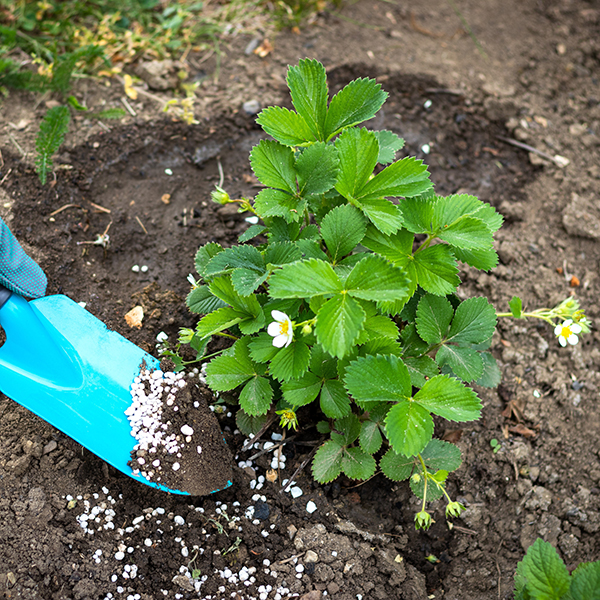There are two basic categories of strawberries – standard and everbearing. Standard (also called June Bearer or Shortday) strawberries set flower buds in August and September for the next spring. Fruit is produced in early to midsummer. Everbearing varieties set flower buds both in the early fall for next spring’s flowers and in the early summer for the current summer and fall’s flowers. Everbearing strawberries fruit in summer followed by a period of little or no production that is followed in late summer by another crop if growing conditions are favorable. They generally produce fewer runners. (A third type, Day Neutral strawberries, are harder to keep fruiting and their overall yield is lower than that of the other two types.)
SPACING: Plants can be grown following one or two systems.
• Matted Row: most effective for varieties that produce many runners. Plants are set about 24” apart in single rows. Rows are spaced 3-4’ apart. Runners are then allowed to fill out a row. As runners grow, space them evenly around mother plant, preferably 3-4” away from any other runner plant. After row is filled, remove and destroy all subsequent runners. Space non-running varieties closer.
• Hill system: most effective for varieties that produce few runners and everbearers. Planting is based on groups of rows forming small individual patches. Groups are 2-3’ apart with two or three rows in a group; rows are 12-18” apart. Set plants 12-18” apart in a row. Remove all runners as they grow.
QUANTITY: 25 plants will produce 20-30 quarts.
SITE REQUIREMENTS:
• Full sun all day.
• Well drained, highly organic soil with a pH of 5.5-6.5. If the soil is heavy, use raised beds to facilitate drainage. Add compost and/or manure to improve tilth and fertility.
• Avoid low pockets where frost damage would be likely to occur.
• Avoid soil recently planted with tomatoes, eggplant, peppers, potatoes, black raspberries or another crop of strawberries. These are all susceptible to verticillium wilt, which is very harmful to strawberries.
POLLINATION: Strawberries are self fruitful.
PLANTING: As soon as the ground is workable, prepare the soil by tilling in a complete fertilizer (5-8-7 or 5-10-5) at the rate of 3 lbs per 100 square feet. Add humus, compost and/or manure to improve drainage and fertility. After the soil is worked and leveled, set plants out in the matted row system or the hill system.
Make an 8” deep slice in the soil with a spade, pulling the spade toward you to create a v-shaped slot. Place the individual plant in the slot with its roots spread out carefully along the vertical side of the slot. Backfill from the slanted side and pack gently until the plant will resist a light tug. Be sure to place the plant at the correct depth, so that the crown is just above surface level.
MAINTENANCE:
• For the first year after planting, remove all flowers. This will encourage good root development.
• Do not fertilize in the early spring (except when first preparing a bed). This will encourage too much new plant growth and soft fruits. Instead, fertilize in August or September (when buds are being set for the next spring’s flowers) with a commercial fertilizer at the rate of about 2 lbs. per 100 square feet.
• Because strawberries are shallow rooted, make sure that they are adequately watered during dry periods.
• Covering the ground with mulch such as straw, salt hay, pine needles or wood chips will aid in keeping the fruit clean, holding moisture, keeping down weeds and protecting the plant in winter. Weed control is most easily achieved with plastic sheeting for few-runner types.
• For winter protection, mulch can be applied so that plant is barely visible and then removed from over the plant to the space between plants in the spring.
• Eventually the mother plants of running types will become unproductive and should be removed. Plants will produce for around three years.
• To control strawberry pests, spray with an all-purpose home orchard spray at first sign of new leaf growth. Follow manufacturer’s directions carefully.
HARVESTING: Any one variety will fruit for about a month, for about 3 weeks under high temperatures. Strawberries ripen rapidly during warm weather and should be picked in the cool of the morning. Leave ½” of stem on each berry when picking. Strawberries can be picked when fully ripe. They can also be picked when 25% of the surface is white or light pink and will ripen within a day; picking at this stage helps to control the diseases that may arise from rotting fruit. Never leave fully ripe fruit on the plants. A combination of several of the standard varieties will produce fruit for harvest from June 1 through July 15. Strawberries can be characterized as early, midseason or late in reference to this time period.
VARIETIES: The following are proven performers in home gardens.
‘Fairfax’ Early. Medium size berry. Bright red outside, deep red inside. Excellent eating, fair for freezing. Especially productive if late season runners are picked off. Can be picked for four weeks or longer.
‘Guardian’ Midseason. One of the best. Highly resistant to verticillium wilt. Huge firm berry with a uniform red color. High yield.
‘Midland’ Very early. Large glossy berry with deep red flesh. Excellent eating and good freezing. At its best when grown in the hill system.
‘Midway’ Early to midseason. Medium to large, glossy, rich, red berries of good dessert and freezing quality. Very heavy producer.
‘Quinalt’ Everbearing. Large, juicy, bright red fruit. Plants are vigorous and productive early. Will have early June crop and bear until frost. Best when planted in the hill system. Virtually no runners, good for pots.
‘Sparkle’ Late. Small to medium size berry with good glossy color and yellow seeds. Fruit is fairly soft, smooth, and has excellent flavor. Excellent eating, preserving, and freezing. One of the most winter hardy.
‘Sunrise’ Early. Berry of medium size with glossy surface and a light bright red color. Flesh is firm and pale pink in color. Plants produce many runners which should be removed for best yield.
‘Surecrop’ Midseason. Light, bright red fruit. Fruit is medium large, firm. Good eating and freezing. Such an extremely vigorous grower that it is important to keep bed from becoming too heavily matted and avoid spring fertilization.






